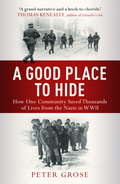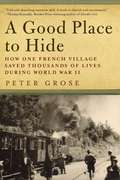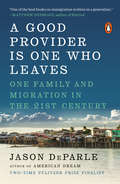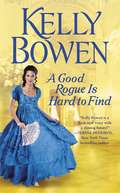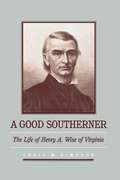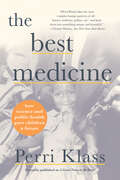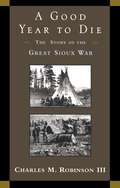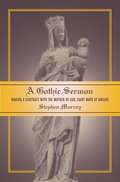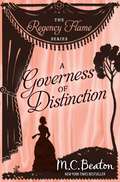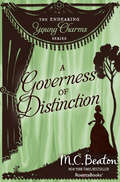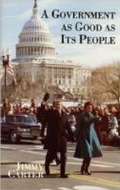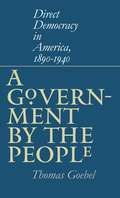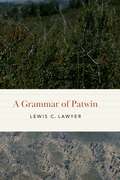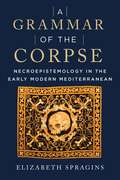- Table View
- List View
A Good Place to Hide: How One Community Saved Thousands of Lives from the Nazis In WWII
by Peter GroseDuring the occupation of France in WWII the villages around Le Chambon-sur-Lignon pulled off an astonishing and largely unknown feat. Risking everything, they underwent a long-running battle of nerves and daring to hide 5,000 men, women and children, 3,500 of them Jews, from the Nazis and their Vichy stooges. Despite the danger, a whole community rallied together, from the pacifist pastor who defied orders to the glamorous female agent with a wooden leg, from the 18-year-old master forger to the schoolgirl who ran suitcases stuffed with money for the Resistance.Told using first-hand testimonies of many of the survivors and face-to-face interviews conducted by the author, A Good Place to Hide is the thrilling story of ordinary people who thwarted the Nazis and sheltered strangers in desperate need.
A Good Place to Hide: How One French Community Saved Thousands of Lives in World War II
by Peter GroseThe untold story of an isolated French community that banded together to offer sanctuary and shelter to over 3,500 Jews in the throes of World War II Nobody asked questions, nobody demanded money. Villagers lied, covered up, procrastinated and concealed, but most importantly they welcomed. This is the story of an isolated community in the upper reaches of the Loire Valley that conspired to save the lives of 3,500 Jews under the noses of the Germans and the soldiers of Vichy France. It is the story of a pacifist Protestant pastor who broke laws and defied orders to protect the lives of total strangers. It is the story of an eighteen-year-old Jewish boy from Nice who forged 5,000 sets of false identity papers to save other Jews and French Resistance fighters from the Nazi concentration camps. And it is the story of a community of good men and women who offered sanctuary, kindness, solidarity and hospitality to people in desperate need, knowing full well the consequences to themselves. Powerful and richly told, A Good Place to Hide speaks to the goodness and courage of ordinary people in extraordinary circumstances.
A Good Provider Is One Who Leaves: One Family and Migration in the 21st Century
by Jason DeParle"No matter your politics or home country this will change how you think about the movement of people between poor and rich countries...one of the best books on immigration written in a generation." --Matthew Desmond, author of EvictedThe definitive chronicle of our new age of global migration, told through the multi-generational saga of a Filipino family, by a veteran New York Times reporter and two-time Pulitzer Prize finalist.When Jason DeParle moved into the Manila slums with Tita Comodas and her family three decades ago, he never imagined his reporting on them would span three generations and turn into the defining chronicle of a new age--the age of global migration. In a monumental book that gives new meaning to "immersion journalism," DeParle paints an intimate portrait of an unforgettable family as they endure years of sacrifice and separation, willing themselves out of shantytown poverty into a new global middle class. At the heart of the story is Tita's daughter, Rosalie. Beating the odds, she struggles through nursing school and works her way across the Middle East until a Texas hospital fulfills her dreams with a job offer in the States. Migration is changing the world--reordering politics, economics, and cultures across the globe. With nearly 45 million immigrants in the United States, few issues are as polarizing. But if the politics of immigration is broken, immigration itself--tens of millions of people gathered from every corner of the globe--remains an underappreciated American success. Expertly combining the personal and panoramic, DeParle presents a family saga and a global phenomenon. Restarting her life in Galveston, Rosalie brings her reluctant husband and three young children with whom she has rarely lived. They must learn to become a family, even as they learn a new country. Ordinary and extraordinary at once, their journey is a twenty-first-century classic, rendered in gripping detail.
A Good Rogue Is Hard to Find (The Lords of Worth #2)
by Kelly Bowen2017 RITA award winning author! HE THOUGHT HE'D SEEN IT ALL . . . The rogue's life has been good to William Somerhall: He has his fortune, his racehorses, and his freedom. Then he moves in with his mother. It seems the eccentric Dowager Duchess of Worth has been barely skirting social disaster-assisted by one Miss Jenna Hughes, who is far too bright and beautiful to be wasting her youth as a paid companion. Now home to keep his mother from ruin, William intends to learn what's afoot by keeping his friends close-and the tempting Miss Hughes closer still.. . . UNTIL HE MEETS HERHe's tall, dark, and damnably intelligent-unfortunately for Jenna. She and the duchess are in the "redistribution business," taking from the rich and giving to the poor, and it's going great - until he shows up. But even as William plots to make an honest woman out of her, Jenna will use all her wiles to reveal just how bad a rogue he can be . . .
A Good Southerner
by Craig M. SimpsonWise (1806-76) was extremely active on the Virginia and national political scene from the early 1830s to the mid-1860s, drawing popular support because of his projection of hopefulness and energy. Regarded as eccentric, Wise is given, in this study, an interpretation that finds consistency in his life-long controversial and impulsive behavior. Simpson stresses Wise's ambivalent attitude toward slaves and slave-holding, authority and authority figures, and Virginia and the United States.
A Good Time to Be Born: How Science And Public Health Gave Children A Future
by Perri KlassThe fight against child mortality that transformed parenting, doctoring, and the way we live. Only one hundred years ago, in even the world’s wealthiest nations, children died in great numbers—of diarrhea, diphtheria, and measles, of scarlet fever and tuberculosis. Throughout history, culture has been shaped by these deaths; diaries and letters recorded them, and writers such as Louisa May Alcott, W. E. B. Du Bois, and Eugene O’Neill wrote about and mourned them. Not even the powerful and the wealthy could escape: of Abraham and Mary Lincoln’s four children, only one survived to adulthood, and the first billionaire in history, John D. Rockefeller, lost his beloved grandson to scarlet fever. For children of the poor, immigrants, enslaved people and their descendants, the chances of dying were far worse. The steady beating back of infant and child mortality is one of our greatest human achievements. Interweaving her own experiences as a medical student and doctor, Perri Klass pays tribute to groundbreaking women doctors like Rebecca Lee Crumpler, Mary Putnam Jacobi, and Josephine Baker, and to the nurses, public health advocates, and scientists who brought new approaches and scientific ideas about sanitation and vaccination to families. These scientists, healers, reformers, and parents rewrote the human experience so that—for the first time in human memory—early death is now the exception rather than the rule, bringing about a fundamental transformation in society, culture, and family life.
A Good War
by Patrick BishopAdam Tomaszewski is a Polish airman, flying Hurricanes alongside British pilots as the Battle of Britain rages in the summer skies over Kent and Sussex. Facing death daily and far from his friends and family, Adam finds himself drawn to a maverick Irish soldier called Gerry Cunningham.'You're out of luck, brother,' are the first words Gerry says when they meet in the crush of men competing for the few women at a dance in a seaside hotel, but when Gerry betrays his lover Moira, Adam's fortunes seem to have changed. For the next four years, Adam's life and Gerry's are intertwined like good luck and bad, love and loss, life and death, their paths crossing at various points on Adam's perilous journey from the ruins of Poland to the rolling English countryside, from Egypt to Occupied France.A hauntingly evocative picture of wartime Britain, a twisting drama of fighting behind enemy lines, a compelling, suspenseful love story, A GOOD WAR proves Patrick Bishop - already acclaimed as a great historian of the war in the air - to be a superbly gifted novelist.
A Good War
by Patrick BishopAdam Tomaszewski is a Polish airman, flying Hurricanes alongside British pilots as the Battle of Britain rages in the summer skies over Kent and Sussex. Facing death daily and far from his friends and family, Adam finds himself drawn to a maverick Irish soldier called Gerry Cunningham.'You're out of luck, brother,' are the first words Gerry says when they meet in the crush of men competing for the few women at a dance in a seaside hotel, but when Gerry betrays his lover Moira, Adam's fortunes seem to have changed. For the next four years, Adam's life and Gerry's are intertwined like good luck and bad, love and loss, life and death, their paths crossing at various points on Adam's perilous journey from the ruins of Poland to the rolling English countryside, from Egypt to Occupied France.A hauntingly evocative picture of wartime Britain, a twisting drama of fighting behind enemy lines, a compelling, suspenseful love story, A GOOD WAR proves Patrick Bishop - already acclaimed as a great historian of the war in the air - to be a superbly gifted novelist.(P)2011 Hodder Headline Ltd
A Good Year to Die: The Story of the Great Sioux War
by Charles M. Robinson IIIHawkes (b. 1925) has been creating fiction since the late 1940s, among his works: The Lime Twig (1961), and The Blood Oranges (1971). This study provides a close look at the work of an author whom Ferrari (English, St. Louis U. ) considers the "least read novelist of substantial merit in the United States. " Annotation copyright by Book News, Inc. , Portland, OR
A Gothic Sermon: Making a Contract with the Mother of God, Saint Mary of Amiens
by Stephen Murray"In this work, Stephen Murray seizes a rare opportunity to explore the relationship between verbal and visual culture by presenting a sermon that may have been preached during the second half of the thirteenth century in or near the cathedral of Notre-Dame of Amiens, whose sculptural program was completed at about the same time. In addition to providing a complete transcription and translation of the text, Murray examines the historical context of the sermon and draws comparisons between its underlying structure and the structure of the cathedral's Gothic portals. He also points out parallels between the rhetorical tools used in the sermon and the stylistic and compositional tools used in the sculpture. In both sermon and cathedral he finds a powerful motivational mechanism that invites the repentant sinner to enter into a new contract with the Virgin Mary. "--BOOK JACKET. Title Summary field provided by Blackwell North America, Inc. All Rights Reserved
A Governanta
by Camille OsterEstelle Winstone nunca havia imaginado que viajaria para terras além das fronteiras da Inglaterra até que recebeu a resposta para seu anúncio oferecendo seus serviços como governanta. Então, terá que viajar até a distante Hungria mesmo que seus nervos estejam à flor da pele, e conhecer o Conde misterioso que agora seria seu novo patrão. Mesmo sem saber falar o idioma dele ou sem alguém que a oriente nos costumes locais, seu novo lar será nas montanhas remotas onde lobos famintos espreitam na escuridão de um castelo marcado com memórias de uma tragédia recente e um longo histórico familiar.
A Governess of Distinction (Regency Flame #3)
by M.C. BeatonThe third book in M.C. Beaton's charming Regency Flame series. Lord Percy Hunterdon despaired: he had inherited a Gothic horror of an estate along with a pair of fifteen-year-old brats to marry off. It was no secret to him that finding husbands for these two vile young ladies would require the utmost expertise: the care of a governess of superior caliber.When Jean Morrison spied Lord Percy's advertisement, dreams of an unmarried viscount and a magnificent castle danced in her head. She imagined him as Byronic and brooding, pacing the battlements with a black cloak wrapped around his manly shoulders. And naturally, he would fall madly in love with her.Her dream burst apart at the seams immediately when she encountered dank, dirty Trelawney Castle and encountered for the first time the evil dispositions of her new charges. Still, despite all of this, the golden hair and dancing eyes of her employer conjured up fantasies that were most unseemly for a governess of distinction.Searching for lighter romances set in the English countryside? Look no farther than the Regency Flame Series, which features mistaken identities, botched marriages, witty heroines, and the courtship of prime Corinthians.
A Governess of Distinction (The Endearing Young Charms Series #4)
by M. C. BeatonA young governess in search of a dream life discovers that grim reality can bring true love in the New York Times–bestselling author’s Regency romance.Lord Percy Hunterdon has inherited a Gothic horror of a country estate along with a pair of teenage brats to marry off. To survive this disastrous fortune, he requires the expertise of a superior governess.When Jean Morrison discovers Lord Hunterdon's advertisement, dreams of an unmarried viscount and a magnificent castle dance in her head. She imagines him as Byronic and brooding, pacing the battlements in a black cloak and falling madly in love with her.It’s a rude awakening when Jean first sees the dank Trelawney Castle and encounters her vile new charges. Still, the golden hair and dancing eyes of her employer conjure up fantasies that are most unseemly for a governess of distinction.
A Governess to Redeem Him
by Lotte R. JamesWhat happens when a governess&’s first love comes back from the dead? Find out in this Gothic second-chance romance. To claim their future They must rewrite their past… Eighteen years ago, Juliana Myles fled her home and built a new life as a governess, believing her childhood sweetheart had been sentenced to death! Now Sebastian Lloyd is back from the dead and wants Juliana&’s help in proving his innocence… Sebastian has spent a lifetime running from an unjust verdict. But he&’s tired of being haunted by his past. Yet working with Juliana to capture the true culprit also means being confronted by searing memories of their passionate history. And the temptation to bring their love story back to life…From Harlequin Historical: Your romantic escape to the past.
A Governess's Guide to Passion and Peril (Ladies Most Scandalous #4)
by Manda CollinsTwo friends reunite—and discover hidden feelings—while investigating a murder in this sensual, witty historical romance perfect for fans of Evie Dunmore and Netflix's Bridgerton! Jane Halliwell once dreamed of a home of her own—but those dreams (and her dowry) died with her father. Now, she works as a governess, preparing her charge for a future no longer within her reach. When her employer is murdered during a house party, however, Jane is forced back into the world of the ton. But stepping in as hostess will require working with the same lord who once broke her girlish heart. Lord Adrian Fielding was too consumed with his job at the Foreign Office to pay young Jane much heed, but he always considered her a friend. Which is why he&’s confounded by her icy demeanor now. More troubling still is his desire to melt the tensions between them. But his mentor&’s murder means he must first find the culprit—and ensure Jane&’s safety as she manages a house full of foreign dignitaries. Only Jane insists on joining the investigation, and Adrian, despite all his diplomatic skills, finds himself seduced by her sharp wit and sparkling eyes. But with a vicious killer circling ever closer, will it soon be too late for their chance at forever?
A Governess's Guide to Passion and Peril: a fun and flirty historical romcom, perfect for fans of Bridgerton (A Lady's Guide)
by Manda CollinsTwo friends reunite - and discover hidden feelings - while investigating a murder in this sensual, witty historical romance perfect for fans of Evie Dunmore and Netflix's Bridgerton!Jane Halliwell once dreamed of a home of her own - but those dreams, along with her dowry, died with her father. Now, she works as a governess, preparing her charge for a future no longer within her reach. However, when her employer is murdered during a house party, Jane is forced back into the world of the ton. But stepping in as hostess will require working with the same lord who once broke her girlish heart.Lord Adrian Fielding was too consumed with his job at the Foreign Office to pay young Jane much heed, but he always considered her a friend. Which is why he's confounded by her icy demeanour now. More troubling still is his desire to melt the tensions between them. But his mentor's murder means he must first find the culprit - and ensure Jane's safety as she manages a house full of foreign dignitaries.Only Jane insists on joining the investigation and Adrian, despite all his diplomatic skills, finds himself seduced by her sharp wit and sparkling eyes. But with a vicious killer closing in, will it soon be too late for their chance at forever?Praise for Manda Collins:'Witty, intelligent, and hard to put down' Rachel Van Dyken'Manda Collins heats up the ballroom and writes romance to melt even the frostiest duke's heart' Tessa Dare'Utterly charming' Popsugar'Manda Collins is a delight!' Elizabeth Hoyt'Mystery, romance, and an indomitable heroine make for a brisk, compelling read' Madeline Hunter'Sexy and smart historical romance, with a big dash of fun' Vanessa Kelly'Sexy, thrilling, romantic . . . Manda Collins makes her Regency world a place any reader would want to dwell' Kieran Kramer
A Government Out of Sight
by Brian BaloghWhile it is obvious that America's state and local governments were consistently active during the nineteenth century, a period dominated by laissez-faire, political historians of twentieth-century America have assumed that the national government did very little during this period. A Government Out of Sight, first published in 2009, challenges this premise, chronicling the ways in which the national government intervened powerfully in the lives of nineteenth-century Americans through the law, subsidies, and the use of third parties (including state and local governments), while avoiding bureaucracy. Americans have always turned to the national government - especially for economic development and expansion - and in the nineteenth century even those who argued for a small, nonintrusive central government demanded that the national government expand its authority to meet the nation's challenges. In revising our understanding of the ways in which Americans turned to the national government throughout this period, this study fundamentally alters our perspective on American political development in the twentieth century, shedding light on contemporary debates between progressives and conservatives about the proper size of government and government programs and subsidies that even today remain 'out of sight'.
A Government as Good as Its People
by Jimmy Carter"This volume presents sixty-two of the best and most notable public statements made by Jimmy Carter on his way to becoming president of the United States. Included are formal speeches on specific issues, such as "Pardon Yes, Amnesty, No" delivered in Seattle, Washington, August 24, 1976; news conferences like the one on "Ethnic Purity" conducted for the American Society of Newspaper Editors in Washington, D.C., April 13, 1976; informal remarks made to political gatherings; interviews (including the controversial Playboy interview from November 1976); and excerpts from the debates with President Ford." "Available again in paperback, this sampling of President Carter's philosophy is extremely readable. Carter's public pronouncements address the major concerns of our time - crime, taxes, technology, poverty, nuclear energy, world order, foreign policy, urban sprawl, human rights, the American family - and collectively stand as a testament to his deeply held conviction that we still can, and must, have "a government as good as its people.""--BOOK JACKET. Title Summary field provided by Blackwell North America, Inc. All Rights Reserved
A Government by the People: Direct Democracy in America, 1890-1940
by Thomas GoebelBetween 1898 and 1918, many American states introduced the initiative, referendum, and recall--known collectively as direct democracy. Most interpreters have seen the motives for these reform measures as purely political, but Thomas Goebel demonstrates that the call for direct democracy was deeply rooted in antimonopoly sentiment. Frustrated with the governmental corruption and favoritism that facilitated the rise of monopolies, advocates of direct democracy aimed to check the influence of legislative bodies and directly empower the people to pass laws and abolish trusts. But direct democracy failed to achieve its promises: corporations and trusts continued to flourish, voter turnout rates did not increase, and interest groups grew stronger. By the 1930s, it was clear that direct democracy favored large organizations with the financial and organizational resources to fund increasingly expensive campaigns. Recent years have witnessed a resurgence of direct democracy, particularly in California, where ballot questions and propositions have addressed such volatile issues as gay rights and affirmative action. In this context, Goebel's analysis of direct democracy's history, evolution, and ultimate unsuitability as a grassroots tool is particularly timely.
A Governors’ Raj
by Michael Fenwick MacnamaraThis book explores the nature and impact of the governor's role in developing government policy, and the consequent effect in British India. Analysing the governors' approaches towards and influence on Indian nationalism and other matters, it examines Lord Irwin's era due to its importance in India's constitutional development. The book explores the governors' contributions to British policy responses towards: the Montford Reforms and dyarchy; the Simon Commission; the Dominion Status Declaration; the First Round Table Conference; communal tensions; the detenu issue; communism, terrorism, Bardoli; Gandhi, civil disobedience and insurgency. It is introduced by an exposition of their constitutional, legal and personal standing in India.
A Gown of Thorns
by Natalie Meg EvansA bittersweet romantic novella set in the rolling valleys of the French Dordogne wine-making region.Shauna Vincent, a graduate from the north of England, has just learned that the job she set her heart on has gone to a socially well-connected rival. Devastated, she accepts an offer in France from an old family friend - to be au pair to the woman's grandchildren. Within a week, Shauna is deep in the Dordogne. With little to do other than organise her two charges' busy social diaries, she has endless hours in which to explore the magical landscape that surrounds her. Her new home is the ancient Chateau de Chemignac with its vineyards and hidden secrets, including a locked tower room where she unearths a trove of vintage gowns, one of which feels unsettlingly familiar. Then Shauna falls asleep one afternoon in a valley full of birdsong, and has a strange dream of a vintage aircraft circling threateningly overhead. So when she suddenly awakes to find charming local landowner Laurent de Chemignac standing over her - Shauna wonders if the dashing aristocrat might be just the person to help her untangle this unexpected message from the past.
A Grain of Truth
by Antonia Lloyd-Jones Zygmunt Miloszewski"A Grain of Truth, like every great crime novel, digs up more unsettling questions than it does answers; it also demonstrates the seemingly endless possibilities of the form itself to serve as smart social criticism." --Maureen Corrigan, on NPR's Fresh AirPraise for the first novel in the Teodor Szacki series:"In Entanglement Miloszewski takes an engaging look at modern Polish society in this stellar first in a new series starring Warsaw prosecutor Teodor Szacki. Readers will want to see more of the complex, sympathetic Szacki."-Publishers WeeklyIt is spring 2009, and prosecutor Szacki is no longer working in Warsaw-he has said goodbye to his family and to his career in the capital and moved to Sandomierz, a picturesque town full of churches and museums. Hoping to start a "brave new life," Szacki instead finds himself investigating a strange murder case in surroundings both alien and unfriendly.The victim is found brutally murdered, her body drained of blood. The killing bears the hallmarks of legendary Jewish ritual slaughter, prompting a wave of anti-Semitic paranoia in the town, where everyone knows everyone. The murdered woman's husband is bereft, but when Szacki discovers that she had a lover, the husband becomes the prime suspect. Before there's time to arrest him, he is found murdered in similar circumstances. In his investigation Szacki must wrestle with the painful tangle of Polish-Jewish relations and something that happened more than sixty years earlier.Zygmunt Miloszewski was born in Warsaw, Poland, in 1975. His first novel The Intercom was published in 2005 to high acclaim. In 2006 he published The Adder Mountains; in 2010, the crime novel Entanglement; and this year its sequel, A Grain of Truth.
A Grammar of Patwin (Studies in the Native Languages of the Americas)
by Lewis C. LawyerPublished through the Recovering Languages and Literacies of the Americas initiative, supported by the Andrew W. Mellon Foundation. A Native American language formerly spoken in hundreds of communities in the interior of California, Patwin (also known as Wintun Tʼewe) is now spoken by a small but growing number of language revitalizationists and their students. A Grammar of Patwin brings together two hundred years of word lists, notebooks, audio recordings, and manuscripts from archives across the United States and synthesizes this scattered collection into the first published description of the Patwin language. This book shines a light on the knowledge of past speakers and researchers with a clear and well-organized description supported by ample archival evidence. Lewis C. Lawyer addresses the full range of grammatical structure with chapters on phonetics, phonology, nominals, nominal modifiers, spatial terms, verbs, and clauses. At every level of grammatical structure there is notable variation between dialects, and this variation is painstakingly described. An introductory chapter situates the language geographically and historically and also gives a detailed account of previous work on the language and of the archival materials on which the study is based. Throughout the process of writing this book, Lawyer remained in contact with Patwin communities and individuals, who helped to ensure that the content is appropriate from a cultural perspective.
A Grammar of Southern Pomo
by Neil Alexander WalkerA title in the Recovering Languages and Literacies of the Americas initiative, supported by the Andrew W. Mellon Foundation.A Grammar of Southern Pomo is the first comprehensive description of the Southern Pomo language, which lost its last fluent speaker in 2014. Southern Pomo is one of seven Pomoan languages once spoken in the vicinity of Clear Lake and the Russian River drainage of California. Prior to European contact, a third of all Pomoan peoples spoke Southern Pomo, and descendants of these speakers are scattered across several present-day reservations. These descendants have recently initiated efforts to revitalize the language. The unique culture of Southern Pomo speakers is embedded in the language in several ways. There are separate words for the many different species of oak trees and their different acorns, which were the people&’s staple cuisine. The kinship system is unusually rich both semantically and morphologically, with terms marked for possession, generation, number, and case. Verbs similarly encode the ancient interactions of speakers with their land in more than a dozen directional suffixes indicating specific paths of movement.A Grammar of Southern Pomo sheds new light on a relatively unknown Indigenous California speech community. In many instances Neil Alexander Walker discusses phenomena that are rare or entirely unattested outside the language and challenges long-standing ideas about what human speech communities can create and pass on to children as well as the degree to which culture and place are inextricably woven into language.
A Grammar of the Corpse: Necroepistemology in the Early Modern Mediterranean
by Elizabeth SpraginsNo matter when or where one starts telling the story of the battle of al-Qasr al-Kabir (August 4, 1578), the precipitating event for the formation of the Iberian Union, one always stumbles across dead bodies—rotting in the sun on abandoned battlefields, publicly displayed in marketplaces, exhumed and transported for political uses. A Grammar of the Corpse: Necroepistemology in the Early Modern Mediterranean proposes an approach to understanding how dead bodies anchored the construction of knowledge within early modern Mediterranean historiography.A Grammar of the Corpse argues that the presence of the corpse in historical narrative is not incidental. It fills a central gap in testimonial narrative: providing tangible evidence of the narrator’s reliability while provoking an affective response in the audience. The use of corpses as a source of narrative authority mobilizes what cultural historians, philosophers, and social anthropologists have pointed to as the latent power of the dead for generating social and political meaning and knowledge. A Grammar of the Corpse analyzes the literary, semiotic, and epistemological function these bodies serve within text and through language. It finds that corpses are indexically present and yet disturbingly absent, a tension that informs their fraught relationship to their narrators’ own bodies and makes them useful but subversive tools of communication and knowledge.A Grammar of the Corpse complements recent work in medieval and early modern Iberian and Mediterranean studies to account for the confessional, ethnic, linguistic, and political diversity of the region. By reading Arabic texts alongside Portuguese and Spanish accounts of this key event, the book responds to the fundamental provocation of Mediterranean studies to work beyond the linguistic limitations of modern national boundaries.
